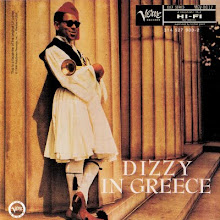
Teddy Wilson's 100th birthday was on November 24th. Frequently noted as the most significant pianist of the swing era, Wilson is perhaps best known in the jazz canon for becoming one of the first black musicians to publicly and prominently appear with white musicians -- in this case, with the Benny Goodman Trio (with drummer Gene Krupa) in 1935.
Drawing from influences Earl “Fatha” Hines and Fats Waller, Wilson began his career in Detroit with bandleaders Bob Cruset, Speed Webb, and Milt Senior (of McKinney’s Cotton Pickers, whose performances Wilson attended in Detroit deeply influenced his decision to pursue a career as a jazz pianist), later making his way to Chicago to play in the big bands of Louis Armstrong, Erskine Tate, and Jimmie Noone.
Wilson’s career truly kicked off after music producer and talent scout John Hammond serendipitously heard Wilson late at night on the radio in New York (as, at the time, Chicago radio stations ran their programming well after the New York programs concluded) and recommended him to bandleader Benny Carter, who drove out to Chicago to hear Wilson and asked him to join his band, which prompted Wilson to move to New York in 1933.
Hammond also introduced Wilson to a second musician that would influence his career -- vocalist Billie Holiday, with whom he recorded a series for Brunswick under his own name (Teddy Wilson and his Orchestra) between 1935 and 1939, which included mass of jazz heavyweights including Johnny Hodges, Ben Webster, Lester Young, Roy Eldridge, Charlie Shavers, Benny Goodman, Gene Krupa, and Pee Wee Russell, among others.
The latter half of Wilson’s career found him as an instructor at the Juilliard School of Music (where he taught Dick Hyman, among others) in the 1950s, several reunion tours with Benny Goodman (including a trip to the USSR in 1962), and recording abroad in Stockholm, the Netherlands, Switzerland, France, and Japan.

This anthology of Teddy Wilson recordings made under his own name in the 1930s and 1940s is superb. There are contributions from most of the major soloists of the era including the trumpets of Roy Eldridge, Bill Coleman, Buck Clayton, Harry James, Charlie Shavers and Bobby Hackett; the saxophones of Ben Webster, Lester Young, Johnny Hodges and Benny Carter; the xylophone of Red Norvo; the clarinet of Benny Goodman and the drums of Jo Jones and Cozy Cole. In addition to all this talent, there are vocals by Billie Holiday, Ella Fitzgerald, Mildred Bailey, Lena Horne, Helen Ward, Maxine Sullivan and Sarah Vaughan.
Sadly, as with all Membran issues, no discographical details are included. However the music is magnificent and arranged in roughly chronological order. It can be divided as follows:
Firstly, there are a number of piano solos from both the 30s and 40s. All are excellent, technically proficient, have a splendid swing and great delicacy of construction. Wilson was one of the great piano stylists of the swing era and these solo tracks are among his finest.
Secondly are his great 'swing-sing' pick-up bands from the late 30's. All the famous, and superb, tracks with Billie Holiday are included. As well as some purely instrumental sides like 'Just a Mood' (which contains what is probably Harry James's finest solo on record), 'Blues in C Sharp Minor' and (with superb Bobby Hackett and Johnny Hodges) 'Jungle Love', there are also some with vocalists other than Billie which are all excellent. These tracks have often been overlooked and it is delightful to have them here.
Thirdly, are some recordings of Teddy Wilson's short-lived big band. The major soloists were Ben Webster and the leader and the arrangements (mainly by Buster Harding) are first class. Another excellent group of recordings - well worth hearing.
Finally, there is a group of recordings from the mid 1940s. These include a small-group with Charlie Shavers and Red Norvo and various pick-up bands.


